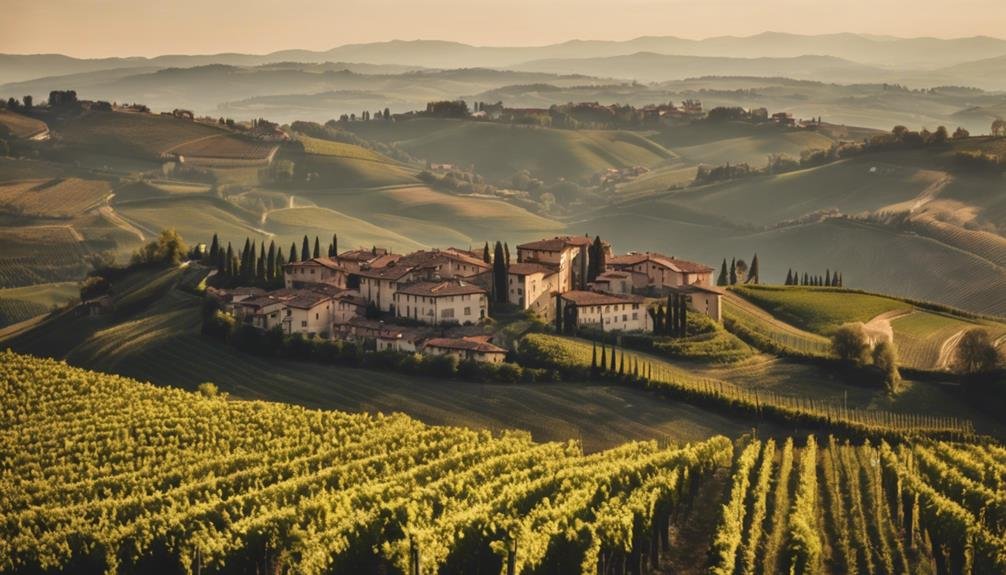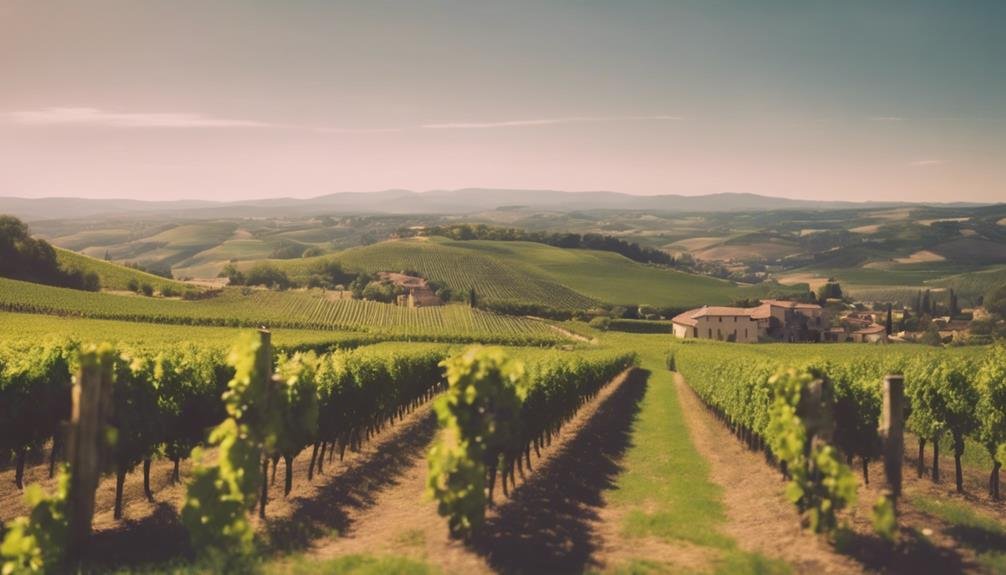Explore Piedmont's wine diversity with Nebbiolo stars like Barolo and Barbaresco. Barolo boasts bold flavors and firm tannins, while Barbaresco offers a lighter touch. Barbera, the region's most planted red grape, shines too. Discover distinct terroirs shaped by the Alps and Apennines, creating unique microclimates. Sub-regions like Langhe and Roero add to the flavorful tapestry. Nebbiolo wines boast complex aromas of roses and cherries. Pair Barolo with rich dishes and Barbaresco with roasted poultry. Delve into Moscato Bianco's intense aromas and Gavi's lemon notes. Piedmont wines shine with DOCG and DOC classifications, offering a world of flavors to savor.
Red Wine Varieties in Piedmont
Piedmont boasts a diverse array of red wine varieties, each offering unique flavors and characteristics that showcase the region's rich winemaking heritage. Nebbiolo diversity is prominent in Piedmont, with Barolo and Barbaresco standing out as the most renowned expressions. Barolo presents bold flavors with rigid tannins, requiring at least 3 years of aging, while Barbaresco offers a lighter, more approachable profile.
Barbera, the most planted red grape variety in Piedmont, delivers a versatile and robust taste. Beyond Nebbiolo, Piedmont offers a range of unique reds like Dolcetto with its dark berry and licorice notes, as well as esoteric varieties such as Quagliano and Grignolino, each contributing distinct flavors to the region's vibrant wine scene.
Wine Regions of Piedmont
Embracing distinctive terroirs and diverse microclimates, the wine regions of Piedmont offer a tapestry of flavors and expressions that reflect the region's rich viticultural heritage.
The vineyard landscapes in Piedmont are characterized by rolling hills, with the Alps to the North and the Apennines to the South influencing the terroir. These geographical features create a unique microclimate, where the interplay of warm Mediterranean winds and cool Alpine breezes shapes the grapes' development.
Each sub-region within Piedmont, such as Langhe, Roero, and Monferrato, contributes its own terroir influence to the wines produced. Understanding the terroir of Piedmont is essential in appreciating the diverse range of flavors found in its renowned wines.
Key Red Wines in Piedmont

Among the key red wines of Piedmont, Nebbiolo stands out as a distinguished varietal revered for its exceptional quality and character. When exploring Nebbiolo profiles, expect complex aromas of roses, cherries, truffles, and herbs, with high acidity and firm tannins.
This noble grape shines in renowned wines like Barolo and Barbaresco, showcasing elegance and longevity. For food and wine pairings, Barolo complements rich dishes like braised meats and aged cheeses, while Barbaresco pairs well with roasted poultry and mushrooms.
The versatility of Nebbiolo allows for delightful matches with a variety of cuisines, making it a favorite among wine enthusiasts seeking bold flavors and refined textures.
White Wines and Pairings
When exploring the diverse wine offerings of Piedmont, the region's white wines and their ideal food pairings stand out as a delightful culinary experience.
Moscato Bianco, an ancient grape variety, captivates with its intense aromas, creating an invigorating and aromatic wine.
Cortese wines from Gavi are celebrated for their lemon-like flavors, perfect for pairing with seafood dishes.
Arneis from Roero DOCG adds a touch of sophistication with its bitter almond notes, making it a versatile choice for various cuisines.
For a perfect Piedmont wine and food experience, consider enjoying Tajarin pasta with Barbaresco to enhance the dish's flavors, indulging in Bagna cauda dip with Barbera for a savory delight, or savoring truffles with a rich Barolo wine for a truly luxurious experience.
Piedmont Wine Terminology

Understanding the terminology associated with Piedmont wines is essential for appreciating the nuances and quality distinctions within this renowned Italian wine region. Here are some key aspects to keep in mind:
- Wine Classifications: Piedmont wines are classified into DOCG and DOC categories, signifying quality designations. For instance, Barolo and Barbaresco are prestigious DOCG wines, while Barbera d'Asti is a notable DOC wine.
- Tasting: Vineyard management techniques greatly influence the flavors of Piedmont wines. Sampling these wines allows one to discern the impact of aging in oak barrels on their profiles.
- Vineyard Management: Proper vineyard management practices play an important role in ensuring the quality of grapes used in Piedmont wines.
- Aging: Aging wine in oak barrels is a common practice in Piedmont, contributing to the development of complex flavors and aromas in the final product.
Frequently Asked Questions
What Are the Unique Winemaking Traditions Specific to Piedmont?
Traditional winemaking techniques in Piedmont focus on slow fermentation processes to extract flavors. Climate influences, with cold Alps and warm Mediterranean, guide vineyard management. This unique balance nurtures grapes like Nebbiolo, Barbera, and Dolcetto.
How Do the Varying Altitudes in Piedmont Affect Wine Production?
Altitude plays a significant role in Piedmont wine production. Higher altitudes bring cooler temperatures, slowing grape ripening and preserving acidity. This results in more structured wines with vibrant flavors. Altitude's impact, combined with climate influence, shapes Piedmont's diverse wine profile.
Are There Any Indigenous Grape Varieties Exclusive to Piedmont?
Indigenous grape varieties exclusive to Piedmont include Nebbiolo, Dolcetto, and Barbera, reflecting the region's rich wine history. Terroir influences, like the Alpine and Mediterranean climates, yield distinct wine styles such as Barolo, Barbaresco, and Barbera d'Asti.
What Is the Significance of the Nebbiolo Grape in Piedmont?
The Nebbiolo grape holds unparalleled significance in Piedmont, embodying tradition through meticulous winemaking techniques. Thriving in the region's diverse soils and altitude-influenced climate, Nebbiolo's exclusivity yields wines of unparalleled depth and complexity, enthralling wine enthusiasts worldwide.
How Do Piedmonts Soil Types Contribute to the Diversity of Its Wines?
Piedmont's diverse soil composition, including clay, limestone, and sand, contributes to the region's wine variety. Different soil types impact vine nutrition and water retention, influencing flavor profiles. This terroir richness enhances the complexity of Piedmont wines.
Conclusion
To sum up, Piedmont's diverse wine regions and flavors offer a sensory journey for wine enthusiasts.
While some may find the terminology and variety of wines overwhelming, exploring Piedmontese wines can be a rewarding and enriching experience.
By immersing oneself in the unique terroirs and flavors of Piedmont, one can truly appreciate the rich viticultural heritage that this region has to offer.
Cheers to discovering the beauty of Piedmont wines!
